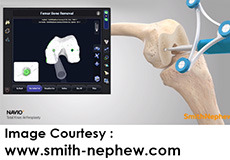
What is Smith & Nephew Navio Robotic TKR?
Navio robotic TKR is a new surgical technique developed by Smith & Nephew which uses robotics to perform total knee replacement through a small incision. The Navio robotic technology allows your surgeon to accurately size and position the implant without the need for a preoperative CT scan or placement of rods in your thigh bone.
Are you the Right Candidate for Smith & Nephew Navio Robotic TKR?
You may be a candidate for Navio Robotic TKR if you have:
- Debilitating knee pain due to arthritis
- Severe knee deformity
- Certain types of knee fractures
- Rheumatoid arthritis of the knee
Contraindications for Smith & Nephew Navio Robotic TKR
Navio Robotic TKR is not performed in:
- Children
- Pregnant women
- Patients suffering from neurogenerative disorders
- Morbidly obese patients
Smith & Nephew Navio Robotic TKR Procedure
The surgical technique is performed as follows:
- You are given general anesthesia or spinal anesthesia.
- A small incision is made near your hip region (most often anterior incision).
- Advanced computer technology is used to prepare a specific plan based on the alignment and anatomy of your knee. There is no need for a CT scan before surgery.
- Navio-specific cutting guides are positioned using the robotics-assisted Navio handpiece. The cutting guides are held in place by a few small pins. There is no need to use intramedullary rods which may damage the central tissue of the bone.
- The cutting guides help in accurately cutting the bones to prepare it to accept the implant components.
- The implant is precisely placed, and the cutting guides are removed.
- The knee is tested through the range of motion and for balanced positioning.
- The incision is closed and covered with a bandage.
Recovery after Smith & Nephew Navio Robotic TKR Procedure
Your surgeon will give you specific instructions regarding the use of pain medication, care of the surgical dressing, the need for physical therapy, and when you can return to routine activities. You must not perform highly intense activities for several weeks otherwise implant failure may occur which is characterized by implant loosening and breakage. You can expect to return to normal activities within 1-1/2 months and resume driving in 2-3 weeks if you are not on any narcotic pain medications.
What are the Benefits of Navio Robotic TKR?
The various benefits of Navio Robotic TKR include:
- No pre-operative CT-scan is necessary
- No exposure to potentially harmful radiation
- A minimum surgical incision is required
- Increased accuracy of implant sizing
- Proper positioning of the implant is achieved
- The longevity of the implant may be improved
- Reduced bleeding
- Decreased risk of complications
- Predictable healing
- Minimum damage to surrounding tissue
- Restoration of leg anatomy
-
NAVIO◊ Surgical System
-
NAVIO◊ partial knee replacement surgery






